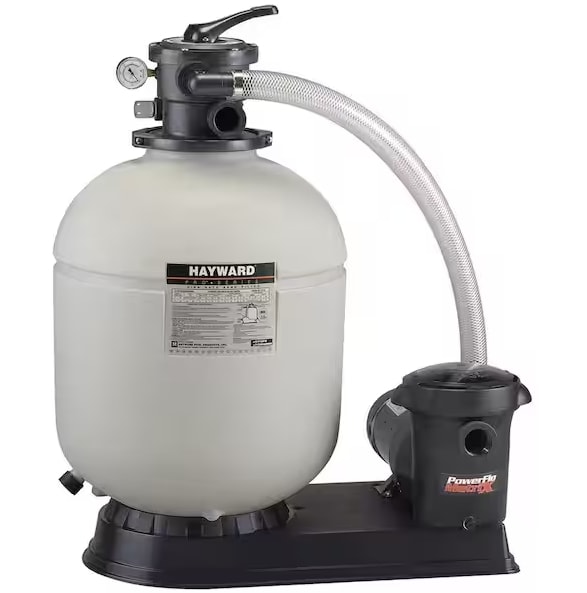Top 9 Questions About Swimming Pool Sand Filters Answered
A sand filter is a tank full of sand connected to your pool's filtration network. As pool water passes through the sand tank, the sand catches debris and particles and prevents them from returning to the pool. This results in cleaner and clearer water.
This is considered the easiest to use and is a popular choice amongst the other varieties. Pool water is pumped through the system and the sand in the filter catches any dirt and debris, purifying and cleaning the water before returning it to the pool.
Sand filters function by moving the water from the top of the tank through the sand to the bottom of the tank via high pressure. As the water trickles down, the sharp edges of the sand grains catch particles like dirt, debris, and body waste materials. Smaller and smaller particles are removed from the water as it cycles through until the sand becomes too dense and needs to be cleaned AKA backwashed.
Best Selling Hayward Sand Filters
Benefits of using Sand Filtration for your pool filter:
- It’s an easy-to-use system
- Requires low maintenance that doesn’t require a service call
- Removes small and large dirt and debris from the pool
- Is relatively inexpensive to install and update
#9 - What maintenance does a sand filter need?
Your pool filter plays a big role in collecting dirt and debris. This is why you need to take the time to make sure your filter is working optimally.
To get rid of the accumulated dirt and debris in your sand filter, you need to carry out backwashing, which is a relatively easy task. Different filters will have varying recommendations for the frequency of backwashing and it will also depend on how dirty your pool gets.
If you look towards your psi and have noticed it has increased by roughly 8 - 10 psi, then this is typically an indicator that your filter is due for a clean.
#8 - How often should a sand filter be serviced?
Servicing your sand filter is an important part of maintaining an efficient pool filtration system. As your sand filter is the main source of the catchment of leaf debris and micro-particles, the sand filter can begin to build pressure and not filter the pool water efficiently. Regular backwash and rinsing routines will aid in the longevity of the sand/media and in keeping the pool water looking its best.
Be careful not to backwash the filter too often because it will filter better when it’s a little dirty. A good rule of thumb is to backwash every time the gauge shows that it’s about 10 pounds higher than it is right after you backwash and then rise the filter.
About every seven years, you should change the sand in the filter. If you’re not using chlorine, you should do it more often, about every three to five years.
#7 - How can you tell if your sand filter is bad?
Knowing how to tell if your sand filter is bad is one of the best ways to keep your pool clean and safe.
- Slow Sand Filter - If your swimming pool seems a bit cloudy or unclear, then you may have a sand filter that’s running slowly.
- Leaking - If the leaking continues long after you’ve finished backwashing, there’s probably a problem with one or more valves, O-rings, or spider gasket seals. Resetting these parts may remedy the problem or they may need to be completely replaced.
- Dirty Sand Filter - If you’ve noticed that the backwashing cycles have become shorter, then you should check to see if the sand filter is dirty or greasy. If the filter is dirty or greasy, don’t be surprised if it looks like a sandy lard. When this happens, the water doesn’t flow through the sand filter media.
- Sandy Pool - It’s common to see a small build-up of sand on the bottom of your pool after replacing the sand in your filter or running the backwash cycle. However, if the amount of sand in your pool increases, you are likely dealing with a broken lateral or standpipe inside the filter.
- Low or High Filter Pressure - For most pools, the ideal sand filter pressure range is from 10 to 25 psi. An obstruction in the system or incorrect sand levels is often the cause for an increase or decrease in pressure.
#6 - How do you know if your sand filter needs new sand?
Over time, sand particles wear down and no longer catch the debris as effectively. If you’re unsure if you’re due for a change, there are certain signs you can watch for:
- Appearance - one of the most obvious signs is changes in the appearance of your water. Cloudy water can be an indication that it is time to change the sand.
- Balling or Channeling - The sand also starts to act differently if it's near the end of its useful life. You might notice that the pool filter sand balls up or that clumps of sand end up in your pool. Another change in the sand can be channels created by the water.
- Excess chemical use - chemicals are a part of proper pool maintenance. If your chemical treatments appear ineffective, or you find yourself using more chemicals than usual, your sand filter could be to blame.
#5 - Can you leave your sand filter out all winter?
It is very important that you properly store your filter system for the winter to avoid any damage that could be caused by the freezing temperatures.
If you happen to live in a place that experiences freezing temperatures in the winter, not closing your pool filtration system properly could lead to your pipes cracking. Make sure to not just close down your filter for the season, but also blow out your pool lines.
#4 - How Often Should You Backwash a Pool Sand Filter?
As a general rule of thumb, you should backwash and rinse your filter about once a fortnight. The optimal time is right after you vacuum the pool. However, if your pool has had a lot more use than normal, it may be necessary to backwash it once a week.
You can also tell when it is time for a backwash by checking the sand filter system’s pressure gauge. Normal operating pressures are between 50 and 75Kpa. When the sand gets dirty and clogged up, however, the pressure reading rises. If the Kpa pressure on the gauge is north of 80Kpa, it’s time to backwash.
Also, if leaves are prone to falling in your pool, more frequent back washing may be necessary since leaves, and other debris and contaminants will be entering your pool. We've also prepared an article dedicated to how to manually vacuum your pool to lessen the need for backwashing so be sure to check it out below.
#3 - How full should your pool sand filter be?
Most sand filters are designed to be filled about two-thirds of the way. This allows for a bit of space above the sandbed but still catches all the water flowing through it. This is a good basic rule to follow, but it is still good to know exactly how many pounds of sand your sand filter requires.
Sand filters generally start at around 16 inches in diameter. For a 16-inch sand filter, you should expect to add around 100 lbs of sand. For every inch in diameter larger than 16 inches, you add an extra 25 lbs of sand until you reach 20 inches. From 20 inches, you add 50 lbs for every 2 inches in diameter until you reach 24 inches. From 24 inches, you add 50 lbs for every 3 inches until you reach 27 inches. For every 3 inches above 27 inches, you will add 150-200 lbs. The largest sand filters are generally around 36 inches.
#2 - Can you use a sand filter with a saltwater pool system?
A sand filter is a great option for salt water pool owners because of it's simple design and ability to keep almost any sized pool clean.
Sand filters are extremely popular because they are affordable and also get the job done. Since sand filters do not catch particles that are as small as salt, they won’t suddenly clog up due to the content of salt in your pool. Most pool owners prefer to use sand filters, but that’s not the only type of filter that you can use for saltwater pools.
#1 - What kind of sand do you use for a sand filter?
The best pool sand you can purchase is a #20 silica sand about 0.5 millimeters in size. It can also be referred to as 20 grit or 20 grade and should be prescreened so it doesn't contain any foreign contaminants. If you use a smaller grain you will run into problems with sand ending up in your pool and possibly causing damage to other components in your pool plumbing system. If you use a larger grain you will be lowering the quality of filtration.
Authorized Dealer for these Pool Products/Manufacturers





We Also Provide Pool Services for these Areas:
Bixby, Broken Arrow, Claremore, Coweta, Jenks, Owasso, Sand Springs, Sapulpa, and Tulsa.



